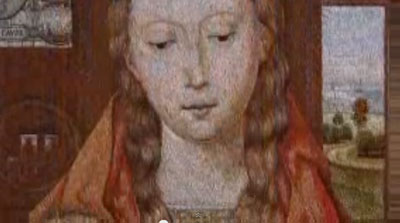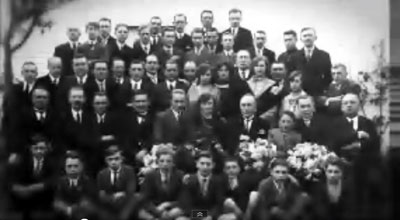Slabbinck is a world-renowned embroidery house in Belgium and a supplier of embroidered church goods world-wide. The history of the company is an interesting one, and their collection of embroidered items from their workshop in the early years is amazing!
Hendrik Slabbinck began his workshop in 1903, in his attic. Since then, despite the troubled years of both world wars, the company has survived for over 100 years, and it still produces embroidered church goods. What fascinates me, though, are the early embroideries that come from the Slabbinck workshops, and the early history of the company.

During World War II, for example, in order to keep his embroiderers from being drafted into the German war effort, Slabbinck worked with the cathedral of Bruges, which placed “fake” orders for embroidered pieces, some of them extremely labor intensive, so that the workshop would appear to be flush with orders and extremely busy. The embroideries that were executed by the embroiderers in the Slabbinck workshop during this time are incredible!

To learn a little more about the company’s history and to see some of their early embroideries, I think it’s well worth it to watch this short video:
(E-mail subscribers can visit the website to view the video.)
During the past week, I’ve watched the video several times over, pausing to look at the different embroideries. Unfortunately, the video is not very clear, but we can still get a good idea of the skill and artistry of these embroiderers. I’d love to see the pieces in person! But… we take what we can get!
I hope you enjoy this little glimpse of a piece of needlework history!







Stunning. I learn so much from your site. Thank you very much for everything you do.
What an amazing place, how I would love to visit. Thank you Mary for giving us this insight to all the beautiful work that has been preserved.
Wonderful article! Thank you. Mary, I did not understand the speaker when he noted the name of the base fabric; only that it is 100% viscose. Are the threads also rayon? Seeing the masterpieces translated into thread creations is amazing.
Laura,
The name of the fabric is “moiré” – the narrator pronounced it “mwaray”.
Hi, Laura – Yes, the fabric is a viscose (as in, rayon) moire – so, think of the water-marked look (like you see in taffeta). I don’t know about the threads. Silk production was certainly slowed (and in many places, broken down completely) down during and after the wars, so rayon (“art silk”) may have been used. But somehow, I can’t image that they would have used rayon threads on something that monumental! ~MC
Their embroideries done in the ’40’s are exquisite – and inspiring. Thank you for presenting this group of embroiderers to us.
The pieces in the video are beautiful beyond words and to think of the dedication of Hendrik Slabinck and his employees is inspiring. Thank you for sharing this story. Now I want to visit Bruges. A friend of mine visited Bruges and came back enthralled and ready to go again.
Dear Mary
Interesting article and beautiful work especially as it was created on viscose material, given the shortages during the second world war I wonder what thread was used. I love the chasuble embroidery on Christ the King amazing. Thanks Mary.
Regards Anita Simmance
Breathtaking beautiful workmanship. Thank you for sharing it with us….
The work this company makes is breath taking. I have been to Bruge but never knew it was there. This work is exquisite and so realistic looking. Thank you for bringing it to us.
What incredible work. I can only think that every stitch made by the workers that were saved having to go to war was stitched with such deep thankfulness! “What ever you do, do it as unto Christ.”
Thank You for sharing this video.
Thank you for this history lesson. Truly amazing. I wish I had known about this when I was walking the cobblestone streets of Brugge many years ago. Their workshops must be phenomenal! Their thread cabinets! Do they publish any tutorials?? I notice that most of the embroidery staff appears to be male. I think I need to go back and watch the video a few more times. such glittering beauty!!
How wonderful ! I had the opportunity to see Slabbink’s “modern” work in an exhibition. They also have a small showroom in Paris, but such masterpieces are not to be seen there. I went there when our office bought a chasuble for our boss (a priest, of course…)
I do have to wonder if “art silk” was used since they used moire as the ground fabric.
Perhaps they are looking at durability as these fibers have come so far in their ability to resist insect damage and the colors are very fast thereby allowing easier cleaning of the garment.
Now, I have no clue if this is correct but just a thought. It surely would be interesting to know the facts.
Hi, Paula!
I think, if they did use “art silk” (and I don’t know if they did – silk was normally the fiber of choice for this level of work) it would have been because of a shortage of silk, due to the wars. As far as durability, etc., goes, silk is certainly a fiber on the top of the list, as the many beautiful centuries-old museum pieces attest. -MC
Mary, I thoroughly enjoyed watching the video and the exquisite work done on the pieces shown,
I did find it interesting that the Christ the King piece being replicated was on a fabric that was 100% viscose. Isn’t that just ‘rayon?”
Lynn
Oops. I see I’m not the only one to comment on the viscose. And I believe it’s been adequately discussed.
Thanks.
Lynn
Thank you for sharing such an informative and beautiful video. You’re awesome!
Thanks for sharing the Slabbinck information. As you mentioned, the video quality was limited but the glimpses of their work were inspiring. You might find the below link of interest as it pertains to ecclesiastical embroidery. Although I am not Orthodox, I have studied w Orthodox iconographers and found the information on embroidery (w pearls and gold)informative.
Thanks,
Cynthia
G’day Mary,
Whoa! What a treasure. Interesting to see the younger folk in the employee photo. They may have been general hands but are all dressed up like the others. In the video though, the embroiderers wear coveralls etc so this may have been a special photo occasion. Germany’s loss of war effort hands at the time was certainly the worlds gain in what was accomplished at the workshop. I especially love the copies of old paintings.
Thank you and cheers, Kath.
Mmm… what a wonderful excuse for needing to make a weekend trip to Bruges. I’m sure that is within my persuasive capabilities.
Fascinating. Thank you for posting this.
“The (reproduction) piece is embroidered on moire, 100% viscose”.
What’s that about?
Do you know why they are reproducing the pieces now? The originals aren’t that old. Did something happen to them?
beautiful…here is Wikiphttp://en.wikipedia.org/wiki/Moire_(fabric)edia on moire…
I was delighted to see your post on the Belgium company Slabbinck. The photos of the original workers and the drawings by Slabbionck himself were fascinating. I have had the pleasure of wear vestments made by Slabbinck although nothing as exquisite as the Christ the King chasuble. Here in our priory at Aylesford in Kent we have a number of old vestments including one purporting to be made by St Mary Magdalene de Pazzi, a 16th Century Carmelite mystic and one of the chasubles which Pope Pius XII gave to all the people who attending the Mass at his enthronement as pope.
Thank you so much for this post,
Michael
Oh Wowowowowow! The story is wonderful and the work is highest artisan and labor of love. Yes, I too would love to see some of the original, or at least closer shots of it. Thanks for sharing.